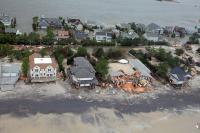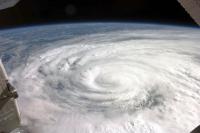-
Better understanding – and forecasting -- of earthquakes

Researchers have broken new ground in understanding the complexity of earthquakes and the possibility to forecast them. The researchers used GPS records of surface motion to map the 7.8 magnitude Gorkha earthquake, which broke a 150-kilometer section of the Himalayas in April 2015, terminating close to Kathmandu.
-
-
Western U.S. braces for “dangerous and deadly” 120 degrees heatwave

Forecasters have warned that temperatures in the western United States are set to reach 120 degrees in a “rare, dangerous, and deadly” heatwave. The forecasts have worried officials, who are bracing for devastating wildfires and power cuts which will knock out air-conditioning systems, leading to heat-related fatalities. The area which will be subjected to the heat wave stretches from Oklahoma to California. It is home to sixty-six million people, one-fifth of the U.S. population.
-
-
Year-long heat streak results in new global heat records
Fresh out of the oven that was a warm start to the year, global temperatures are on a roll: For the 13th consecutive month, the globe was record warm in May — the longest such stretch in 137 years of record-keeping. The more than yearlong heat streak also resulted in other new global heat records.
-
-
Future summers could regularly be hotter than the hottest summers on record
In fifty years, summers across most of the globe could regularly be hotter than any summer experienced so far by people alive today, according to a new study. If climate change continues on its current trajectory, the probability that any summer between 2061 and 2080 will be warmer than the hottest on record is 80 percent across the world’s land areas, excluding Antarctica, which was not studied. If greenhouse gas emissions are reduced, however, that probability drops to 41 percent, according to the study.
-
-
Danger from extreme storms, high seas on the rise
Storms that battered Australia’s east coast are a harbinger of things to come and a stark reminder of the need for a national effort to monitor the growing threat from climate change, researchers warn. “The damage we’ve seen is a harbinger of what’s to come,” said one expert. “Climate change is not only raising the oceans and threatening foreshores, but making our coastlines much more vulnerable to storm damage. What are king high tides today will be the norm within decades.”
-
-
France unveils app to alert people to terror attacks
Euro 2016 soccer tournament begins on Friday, and as part of the massive security operation undertaken to secure the ten millions spectators who will be watching the games from 10 June to 10 July, the French government has created a smartphone app designed to send warnings directly to people’s phones in the event of a bombing, shooting, or other disaster.
-
-
New app to gather public input on flash flooding conditions
A new Android cell phone app called iSeeFlood encourages the public to file timely reports when they see flooding of varying severity on the streets, in and around their houses, and in streams and creeks. Such flash floods can be dangerous to pedestrians and motorists alike.
-
-
Cities can prepare for hurricane season by reforming shortsighted and outdated laws
In the past decade major storms have devastated U.S. coastal cities from Galveston to Atlantic City and New York. They also have ravaged inland capitals, including Baton Rouge, Richmond, and Montpelier. Ensuring that our cities have the legal infrastructure in place to build safer, more efficient, and more equitable neighborhoods and communities after storms is just as important as preparing homes and businesses to ride out those storms.
-
-
New USGS models help predict storm effects on beaches

As the 2016 hurricane season opens, weather forecasters, emergency managers and coastal residents have access to tools developed by the USGS which predict, more precisely than ever, where beach erosion and beachfront flooding will take place during hurricanes and other storms.
-
-
Near-normal Atlantic hurricane season is most likely this year: NOAA
NOAA’s Climate Prediction Center says the 2016 Atlantic hurricane season, which runs from 1 June through 30 November, will most likely be near-normal, but forecast uncertainty in the climate signals that influence the formation of Atlantic storms make predicting this season particularly difficult. NOAA predicts 70 percent likelihood of 10 to 16 named storms.
-
-
Groundwater extraction contributes less to sea level rise than previously thought

Groundwater extraction and other land water contribute about three times less to sea level rise than previous estimates, according to a new study. The study does not change the overall picture of future sea level rise, but provides a much more accurate understanding of the interactions between water on land, in the atmosphere, and the oceans, which could help to improve future models of sea level rise.
-
-
Changing climate threatens World Heritage, tourism sites
Climate change is fast becoming one of the most significant risks for World Heritage sites across the globe. Many World Heritage sites, designated for their global significance and universal value to humankind, are major tourist destinations. Some are among the most iconic places on Earth.
-
-
Improving hurricane intensity predictions through early use of “hurricane hunter” data

Data collected via airplane when a hurricane is developing can improve hurricane intensity predictions by up to 15 percent, according to researchers who have been working with the National Oceanic and Atmospheric Administration and the National Hurricane Center to put the new technique into practice.
-
-
A warning system for tsunamis

Right now, tsunami warning systems rely on region-specific scenarios based on previous patterns in that area. This is because scientists use sensors in the ocean, which can detect abnormal movements but cannot make accurate projections of how much water will hit a coast and how hard. But “most likely” is not a sure thing. Seismologists have created a new algorithm that could one day help give coastal cities early warning of incoming tsunamis.
-
-
Flood preparedness: There’s a new USGS app for that
During the recent Texas flooding, the U.S. Geological Survey (USGS) unveiled a new tool that gives users real-time water, weather and National Weather Service flood forecast information all in one place. When water levels are rising, it can be hard to quickly get all the information you need about your area, especially when you are not in front of a computer.
-
More headlines
The long view
Trump Aims to Shut Down State Climate Policies
By Alex Brown
President Donald Trump has launched an all-out legal attack on states’ authority to set climate change policy. Climate-focused state leaders say his administration has no legal basis to unravel their efforts.
